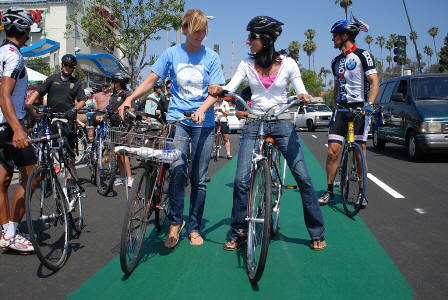After four years, many complaints, many praises, and a final acceptance that they really aren't that bad, the green Sharrows in Belmont Shore have turned 4. And with that, data have been released so that we can figure out precisely what we've learned.

The Sharrows stretch along 2nd street in between Bayshore and Livingstone Drives along a street that is heavily commercial: With 15 blocks, there are 14 stop lights and a consistent push for parking that borders the intensity of hell sometimes. In other words, more than acting as a complete street, it acted as some vehicular arterial that welcomed pedestrians but forced bicyclists to dangerously roll along the sidewalk or uncomfortably ride in traffic untuned to their presence.
Hence the Sharrows which, according to Bike Long Beach, was created for three reasons: encourage bicyclists to ride the lane safely; reduce bicyclists on sidewalks to increase safety; and encourage bicycling on a larger scale.
But have they proven effective?
According to the data, somewhat yes. For the two and a half years prior to the Sharrows being installed—2007 to mid-2009—Belmont Shore had over 90 crashes of which nine involved bikes and two involved a pedestrian.
Following the Sharrows completion on June 25, 2009, there was a drop in overall collisions in 2010 and 2011—33 and 27 respectively—but a spike in bicyclist—4 and 6—as well as pedestrian collisions in 2011 with 3. Then it drops for 2012 drastically, with just 12 collisions overall and no bicyclist/ped-involved collisions.
2011 could be easily explained by the getting-used-to-them factor, where admittedly drivers were relatively baffled by what Sharrows are. So in a sense, particularly over time, the Sharrows have been effective in increasing safety.
Even more, the last bike count concluded that double the amount of bicyclists are using the Sharrows, with it not uncommon to find more bikes—150 to 200—shackled along 2nd than cars.<What's intriguing is the fact that the LA County Bicycle Coalition released a report that had shown the exact opposite of Long Beach's results: Sharrows, for the most part, do not increase ridership at all and act as a temporary bandage—be it politically or economically driven—to a much larger need for more separatist infrastructure like bike lanes.
I particularly can't speak for Los Angeles since I have actually ridden there very little in the grand scheme of things—so I can only theoretically speculate that, beyond this universal idea that we must create pathways that do not "exceed [bicylists'] tolerance for traffic stress," we must reevaluate claims.
And it is here where I simply open up dialogue because I don't have answers more than I have questions: Given Long Beach's success thus far, should we be dismissing the idea of Sharrows en tout—or is this a temporary blip that San Diego and Los Angeles have overcome and Long Beach will revert to the same? Is this a matter of educating, given Long Beach's rather in-your-face ad campaign about sharing the road—or just a matter of city size and the placement of sharrows?
Even more, should we be avoiding Sharrows as "main connections" and instead using them for areas reserved for limited distances rather arterials? Because the blunt reality--and something I proffer to Los Angeles and San Diego--is that this all depends on how you define whether or not Sharrows "work." If your only goal is to increase ridership--rather than direct bicyclists onto safer paths, help connect bicyclists away from streets that are too narrow, increase the safety on downhill routes--then yes, I understand your concerns. But if not, we should talk because Sharrows work rather brilliantly in the other senses.






